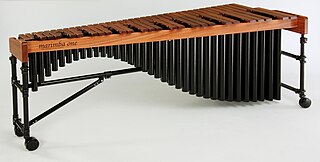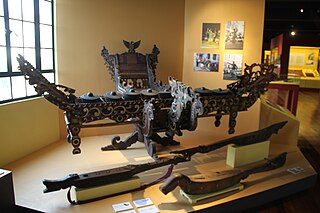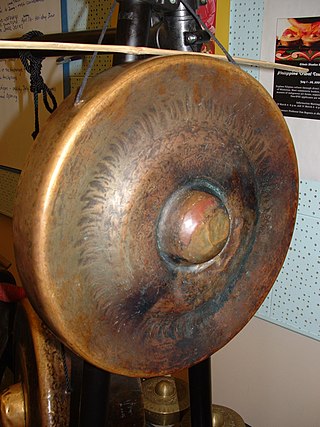
The xylophone is a musical instrument in the percussion family that consists of wooden bars struck by mallets. Like the glockenspiel, the xylophone essentially consists of a set of tuned wooden keys arranged in the fashion of the keyboard of a piano. Each bar is an idiophone tuned to a pitch of a musical scale, whether pentatonic or heptatonic in the case of many African and Asian instruments, diatonic in many western children's instruments, or chromatic for orchestral use.

The marimba is a musical instrument in the percussion family that consists of wooden bars that are struck by mallets. Below each bar is a resonator pipe that amplifies particular harmonics of its sound. Compared to the xylophone, the marimba has a lower range. Typically, the bars of a marimba are arranged chromatically, like the keys of a piano. The marimba is a type of idiophone.

Kulintang is a modern term for an ancient instrumental form of music composed on a row of small, horizontally laid gongs that function melodically, accompanied by larger, suspended gongs and drums. As part of the larger gong-chime culture of Southeast Asia, kulintang music ensembles have been playing for many centuries in regions of the Southern Philippines, Eastern Malaysia, Eastern Indonesia, Brunei and Timor, Kulintang evolved from a simple native signaling tradition, and developed into its present form with the incorporation of knobbed gongs from Sundanese people in Java Island, Indonesia. Its importance stems from its association with the indigenous cultures that inhabited these islands prior to the influences of Hinduism, Buddhism, Islam, Christianity or the West, making kulintang the most developed tradition of Southeast Asian archaic gong-chime ensembles.

The angklung is a musical instrument from the Sundanese people in Indonesia made of a varying number of bamboo tubes attached to a bamboo frame. The tubes are carved to have a resonant pitch when struck and are tuned to octaves, similar to Western handbells. The base of the frame is held in one hand, while the other hand shakes the instrument, causing a repeating note to sound. Each performer in an angklung ensemble is typically responsible for just one pitch, sounding their individual angklung at the appropriate times to produce complete melodies.

The suling is a musical instrument of the Sundanese people in Indonesia. It is used in the Degung ensemble. Bamboo ring flute can also be found in Southeast Asian, especially in Brunei, Indonesia, Malaysia, the Philippines and Singapore.

Mizoram is a region in India. Its folk music consists of vocals (singing) accompanied by traditional drums, gong and other native percussion instruments. There is also a long history of flute-playing which is now defunct. The drums are made from a hollow tree trunk with membrane made from cow hide and the gongs, made of brass, are very similar to those found in Myanmar.

The babandil is a single, narrow-rimmed Philippine gong used primarily as the “timekeeper” of the Maguindanao kulintang ensemble.

A gambang, properly called a gambang kayu is a xylophone-like instrument used in Indonesian gamelan and kulintang ensembles. It has wooden bars (wilah) in contrast to the metallic ones of the more typical metallophones in a gamelan. A largely obsolete instrument, the gambang gangsa, is a similar instrument made with metal bars.
Traditional Vietnamese musical instruments are the musical instruments used in the traditional and classical musics of Vietnam. They comprise a wide range of string, wind, and percussion instruments, used by both the Viet majority as well as the nation's ethnic minorities.

The vinta is a traditional outrigger boat from the Philippine island of Mindanao. The boats are made by Sama-Bajau, Tausug and Yakan peoples living in the Sulu Archipelago, Zamboanga peninsula, and southern Mindanao. Vinta are characterized by their colorful rectangular lug sails (bukay) and bifurcated prows and sterns, which resemble the gaping mouth of a crocodile. Vinta are used as fishing vessels, cargo ships, and houseboats. Smaller undecorated versions of the vinta used for fishing are known as tondaan.
Traditional Thai musical instruments are the musical instruments used in the traditional and classical music of Thailand. They comprise a wide range of wind, string, and percussion instruments played by both the Thai majority as well as the nation's ethnic minorities.

The ranat ek is a Thai musical instrument in the percussion family that consists of 21 wooden bars suspended by cords over a boat-shaped trough resonator and struck by two mallets. It is used as a leading instrument in the piphat ensemble.

The Roneat Ek or Roneat Aek is a xylophone used in the Khmer classical music of Cambodia. It is built in the shape of a curved, rectangular shaped boat. It has twenty-one thick bamboo or hard wood bars that are suspended from strings attached to the two walls. They are cut into pieces of the same width, but of different lengths and thickness. Originally these instruments were highly decorated with inlay and carvings on the sides of the sound box. Now they are simpler. The Roneat is played in the Pinpeat ensemble. In that ensemble, sits on the right of the Roneat Thung, a lower-pitched xylophone. The roneat ek is the analogous equivalent to the Thai xylophone called ranat ek, and the Burmese bamboo xylophone called "pattala".

The roneat thung or roneat thum is a low-pitched xylophone used in the Khmer classical music of Cambodia. It is built in the shape of a curved, rectangular shaped boat. This instrument plays an important part in the Pinpeat ensemble. The roneat Thung is placed on the left of the roneat ek, a higher-pitched xylophone. The Roneat Thung is analogous to the ranat thum of Thai.
The Culture of Basilan are derived from the three main cultural ethnolinguistic nations, the Yakan, Suluanon Tausug and the Zamboangueño in the southern Philippines. Both Yakans and Tausugs are predominantly Muslim, joined by their kin from the Sama, Badjao, Maranao, and other Muslim ethnolinguistic groups of Mindanao, while the Zamboangueños are primarily Christian, joined by the predominantly Christian ethnolinguistic groups; the Cebuano, Ilocano, Tagalog and others. These three main groups, however, represent Basilan's tri-people or tri-ethnic group community.
The kolitong is a bamboo polychordal tube zither from Bontok, Kalinga, Philippines with six strings that run parallel to its tube body. The strings are numbered from one to six, from lowest to highest pitch. The body acts as the instrument's resonator. The body may be a whole tube or a half tube. In both cases, the two ends of the body are closed by the bamboo nodes. To help with the resonance of the instrument, holes are made on both nodes and long cracks are made along the body parallel to the strings.

The Diwas is a native bamboo wind instrument from the Philippines that is a variation of the well-known pan flute or panpipes. It is made of bamboo, with one end closed with bamboo nodes. It does not have finger holes like other popular aerophones, such as flutes. The Diwas compensates by grouping pipes of graduated lengths together. The player shifts from one pipe to another to produce sounds with varying pitches. In Kalinga, these individual pipes are known as saggeypo, which is why the Diwas is sometimes called saggeypo. The number of attached saggeypos can range from five to eight.

Roneat is the generic Khmer word for referring to several types of xylophones used in traditional Cambodian music; the pinpeat and mohaori.
Uwang Ahadas was a Filipino folk musician of the Yakan people who was a recipient of the National Living Treasures Award.














